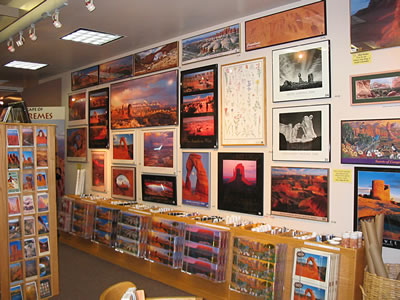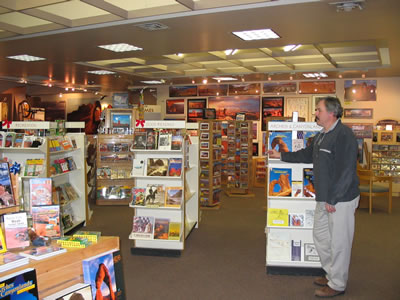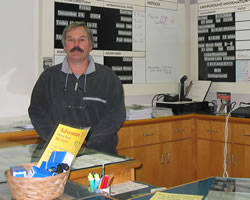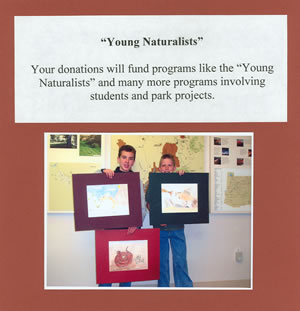
A tone of respect for the land is
all encompassing the minute I walk into the Moab Information
Center. It always is.
It’s a sensory thing: sight, sound and touch; meandering
river, flutes, and toys.
No wonder so many people “come back” to Moab.
The Moab Information Center is just that: a central, managing partner
with Canyonlands Natural History Association, the National Park Service,
the Bureau of Land management and the U.S. Forest Service. The people
here who greet visitors to Moab love this area. They convey that love
by putting the best of what Southeastern Utah’s natural world has
to offer on display. The people that work here are often a visitor’s
first contact.
“The classic thing people say when they come in is, ‘I just got to
town, what should I do?’’” says staff coordinator Chuck Schildt. “I
ask how much time they have. Usually it’s a day and a half. I tell them
to spend a whole day in Arches National Park, and for the half day to get up
to Dead Horse Point.
“That’s just a taste,” he adds. “They’ll have to
come back and spend more time.”
 The
Information Center has everything a visitor, and local for that matter,
needs to whet the appetite for adventure and contemplation. Maps, books,
videos and schedules abound. The center’s 75-seat auditorium offers
a 12-minute video that gives visitors an overview of the 7.5 million
acres of federal land in Southeast Utah available for various types of
recreation. The
Information Center has everything a visitor, and local for that matter,
needs to whet the appetite for adventure and contemplation. Maps, books,
videos and schedules abound. The center’s 75-seat auditorium offers
a 12-minute video that gives visitors an overview of the 7.5 million
acres of federal land in Southeast Utah available for various types of
recreation.
“First and foremost we are here to give people information,” Schlidt
said. “Second, we sell products that may help them enjoy the area, learn
more about it or remind them of it when they leave.”
The quality products include books, postcards, games, blocks, posters,
water bottles, magnets – just about anything – but all related
to the natural history of canyon country. Proceeds from the sale of these
products are channeled right back into three government and one non-profit – BLM,
Forest Service, Park Service and CNHA – to generate more visitor
services and educational materials.
Many local students wind their way through the Moab Information Center,
where they are first introduced to the video “Painted Canyons.” Students
are then invited to the Interpretive section, where gorgeous photos of
range land, canyons, wetlands, river and mountains accompany hands-on
question and answer windows, resolving such mysteries as “How deep
is the river?” and “How does desert varnish form?”
“We have a replica of rock art that we allow them to touch, but we are
sure to tell them they can never touch rock art when they find the real thing,” Schildt
said.
 “Some
of the kids who come in here have never even been to Arches,” he
continues. “I tell them to get their parents to take them – it’s
in their own backyard. This land, these sites are so old – it’s
part of our heritage. Developing a love for the outdoors when they’re
young is like developing a love for reading. That’s something they’ll
always remember.” “Some
of the kids who come in here have never even been to Arches,” he
continues. “I tell them to get their parents to take them – it’s
in their own backyard. This land, these sites are so old – it’s
part of our heritage. Developing a love for the outdoors when they’re
young is like developing a love for reading. That’s something they’ll
always remember.”
Skiing, rafting, 4-wheeling, biking and sightseeing – all of these
are highlighted, with an eye toward safety and respect for the land.
“You want people to have an enjoyable trip and you want them to have a
safe trip,” Schildt said. “We can’t stress the importance of
water enough. People get hurt when they don’t bring enough water.”
Schildt also tells visitors “Don’t bust the crust.”
“We talk about cryptobiotic soils. We send kids home with buttons that
say ‘Don’t Bus the Crust.’ We want to preserve the area for
their kids and their kids’ kids.”
Schildt said that the Visitor’s Center averages 1,000 people a
day during the peak season, but can serve as many as 1,500. There is
a staff of eight people who are charged with greeting, smiling and informing
visitors.
Locals and visitors enjoy the Moab Information Center Lecture Series,
which averages an attendance of 50 people per presentation, up from 40
last year. There are usually two lectures per month, but sometimes, if
scheduling allows and material is available, there can be three or four
lectures. Conversely, on a slow month – like December, there may
only be one.
“I try to get as many locals as I can to do the lectures,” Schildt
said. “And usually they will talk about some aspect of this area. But if
somebody takes a killer trip to South America, that’s something of interest
to people too.”
The lectures are held in the auditorium, and are usually accompanied
by slides and/or some other kind of media. They are usually held on Thursdays
at 7 p.m.
Events scheduled already for the coming year include:
January
7 (FRIDAY) – Evan
Stevens: Basic Avalanche Awareness;
February 17 – Rick Boretti: Peregrine Falcons;
March 31 – Tom Till: Desert World;
April 14 – David Eggeling: Photography.
The Moab Information Center is located
at the corner of Center and Main Streets in Moab, and can
be reached by calling 259-2468.

|

 The
Information Center has everything a visitor, and local for that matter,
needs to whet the appetite for adventure and contemplation. Maps, books,
videos and schedules abound. The center’s 75-seat auditorium offers
a 12-minute video that gives visitors an overview of the 7.5 million
acres of federal land in Southeast Utah available for various types of
recreation.
The
Information Center has everything a visitor, and local for that matter,
needs to whet the appetite for adventure and contemplation. Maps, books,
videos and schedules abound. The center’s 75-seat auditorium offers
a 12-minute video that gives visitors an overview of the 7.5 million
acres of federal land in Southeast Utah available for various types of
recreation. “Some
of the kids who come in here have never even been to Arches,” he
continues. “I tell them to get their parents to take them – it’s
in their own backyard. This land, these sites are so old – it’s
part of our heritage. Developing a love for the outdoors when they’re
young is like developing a love for reading. That’s something they’ll
always remember.”
“Some
of the kids who come in here have never even been to Arches,” he
continues. “I tell them to get their parents to take them – it’s
in their own backyard. This land, these sites are so old – it’s
part of our heritage. Developing a love for the outdoors when they’re
young is like developing a love for reading. That’s something they’ll
always remember.”